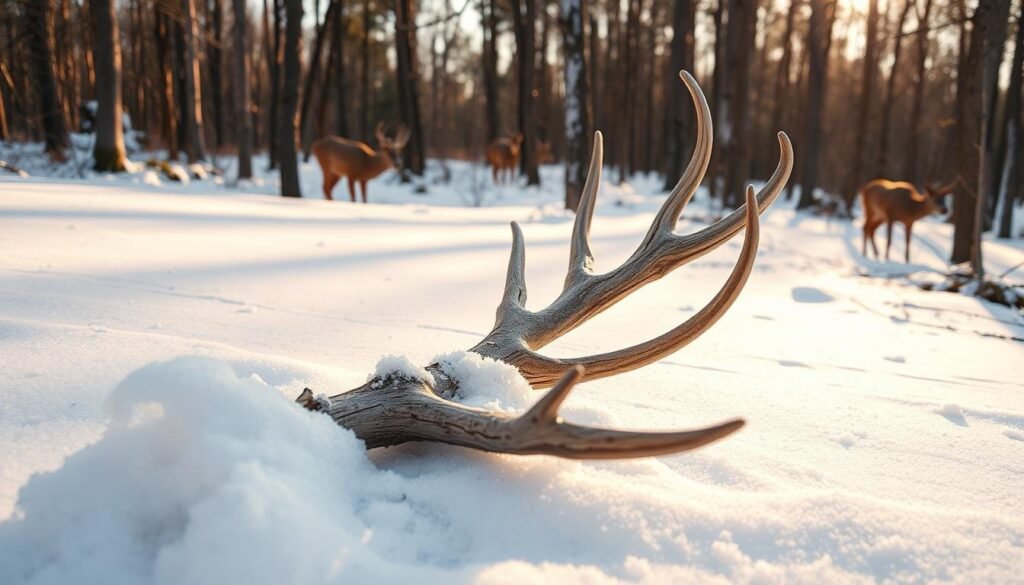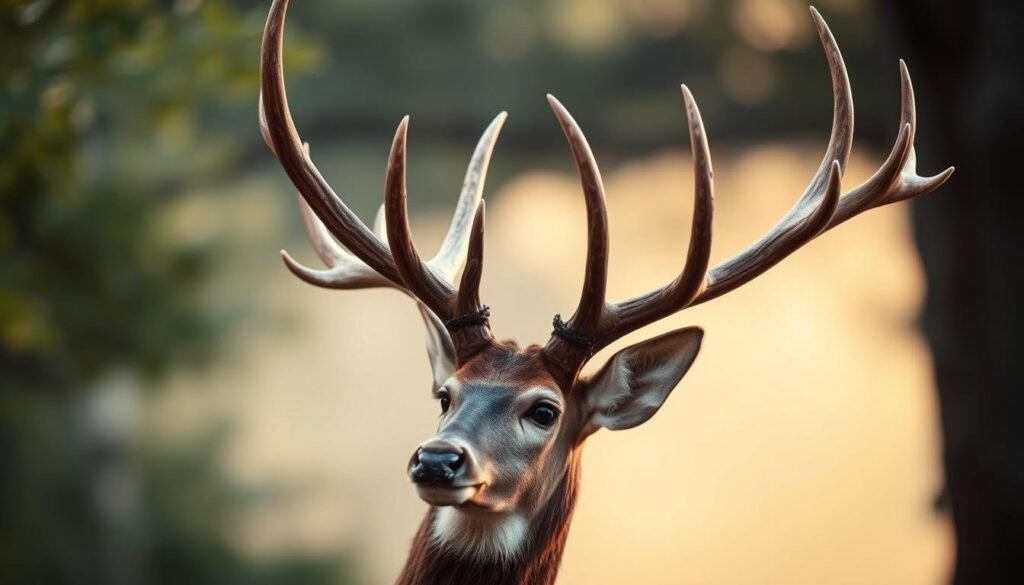Why Deer Lose Their Antlers Every Year? You’re about to dive into the world of deer and their amazing antlers. Every year, they shed their antlers and grow new ones. This process is fascinating and crucial for their survival.
As you continue reading, you’ll learn more about deer and their antlers. The antler shedding process is a natural part of their life. It helps them adapt to their environment.
Exploring this annual event will show you the complex mechanisms behind it. You’ll also learn more about these incredible animals.
Contents
- 1 The Remarkable Cycle of Antler Growth
- 2 Why Do Deer Shed Their Antlers Annually?
- 3 The Seasonal Timeline of Antler Shedding
- 4 The Biological Purpose of Antlers
- 5 The Ecological Impact of Shed Antlers
- 6 Hunting for Sheds: A Growing Outdoor Pursuit
- 7 Conclusion: Why Deer Lose Their Antlers Every Year?
- 8 FAQ
- 8.1 Why do deer shed their antlers every year?
- 8.2 What is the purpose of antlers in deer behavior?
- 8.3 When do deer typically shed their antlers?
- 8.4 What happens to shed antlers in the ecosystem?
- 8.5 How fast do deer antlers grow?
- 8.6 What is shed hunting, and why do people enjoy it?
- 8.7 How do hormonal changes affect antler shedding?
- 8.8 Are antlers made of bone?
The Remarkable Cycle of Antler Growth
Deer antlers are not just impressive structures; they are a key part of a deer’s life. They grow and shed in a remarkable cycle. The growth of antlers is a complex process that involves bone, cartilage, and skin.
Antlers can grow up to an inch per day. This rapid growth is fueled by a rich supply of blood and nutrients. As the antlers grow, they are covered in a soft, velvety skin that eventually dries and is rubbed off by the deer.
The annual antler growth cycle shows how deer are adaptable and resilient. As the seasons change, deer prepare for the shedding of their antlers. This process is linked to their mating rituals and survival strategies.
By studying the deer antler shedding cycle, we learn about deer behavior. This knowledge helps us appreciate these magnificent creatures. It also informs conservation efforts and wildlife management practices.
Why Do Deer Shed Their Antlers Annually?
The annual shedding of antlers is a fascinating process in deer biology. As days get shorter and weather cools, hormonal changes start the shedding. This is key for deer survival, helping them save energy and resources.
Shedding antlers lets deer focus on finding food and avoiding predators. Hormonal changes play a big role in this process.
Hormonal Changes and Antler Shedding
Hormonal changes, especially a drop in testosterone, explain why deer shed their antlers. As daylight hours go down, testosterone levels fall. This triggers the deer’s body to start shedding antlers.
This process has several stages, as shown in the table below:
| Stage | Description | Hormonal Influence |
|---|---|---|
| 1. Preparation | Deer’s body starts preparing for shedding as daylight hours decrease. | Decrease in testosterone |
| 2. Shedding | Antler shedding occurs due to the weakening of the pedicle. | Further decrease in testosterone |
| 3. Regrowth | New antler growth begins as daylight hours increase. | Increase in testosterone |
Understanding the deer antler shedding cycle shows the amazing biology behind it. Shedding antlers helps deer survive and thrive in their environments.
As you learn more about deer biology, you’ll see how complex their lives are. The annual shedding of antlers is just one of the many interesting parts of deer biology.
The Seasonal Timeline of Antler Shedding
Deer antler shedding follows a seasonal pattern. In most areas, they shed their antlers in late winter or early spring. This timing helps them save energy during cold months.
Shedding antlers lets deer use less energy. They can then focus on staying alive. The exact time of shedding depends on climate, nutrition, and genetics. For example, colder climates might see later shedding than milder ones.
The growth of new antlers is tied to seasonal changes. Deer grow new antlers in spring and summer, shedding them in late winter. The size of antlers can depend on food availability.
| Season | Antler Growth Stage | Influencing Factors |
|---|---|---|
| Spring | New antler growth begins | Nutrition, daylight hours |
| Summer | Antler growth continues | Food availability, temperature |
| Late Winter | Antler shedding occurs | Climate, genetics, nutrition |
Learning about deer antler shedding can deepen our understanding of these animals. It shows their adaptability and resilience through the annual cycle of growth and shedding.
The Biological Purpose of Antlers
Antlers serve many purposes in deer lives. They help deer show who’s boss, find mates, and keep predators away. Antlers are key to a deer’s life, playing a big role in their social life and survival.
Deer grow and lose antlers every year. This process is costly but very important. Genetics, food, and hormones affect how antlers grow. The velvet on antlers is full of blood vessels, giving them the nutrients they need.
When antlers are fully grown, the velvet falls off. This usually happens before mating season. At this time, antlers help deer show off their strength and attract mates. The size and shape of antlers can show how healthy and strong a deer is.
Functions of Antlers
Antlers have several important roles in deer behavior:
- Establishing dominance within a social hierarchy
- Attracting mates during the mating season
- Defending against predators and rival deer
The process of losing antlers is also vital. It helps deer save energy when they don’t need antlers. When and how deer lose their antlers can change based on their age, diet, and the environment.
| Function | Description | Significance |
|---|---|---|
| Establishing Dominance | Antlers are used to establish a hierarchy among deer, with larger antlers indicating higher dominance. | Crucial for social structure and mating rights |
| Attracting Mates | The size and complexity of antlers can attract potential mates. | Important for reproductive success |
| Defense Mechanism | Antlers can be used to defend against predators and rival deer. | Vital for survival and protection of territory |
In conclusion, antlers are very important for deer. They help deer show who’s boss, find mates, and stay safe. Knowing about antlers helps us understand deer’s complex lives better.
The Ecological Impact of Shed Antlers
Deer shedding their antlers has a big impact on ecosystems. It provides nutrients and resources for other species. You might see deer antler remains in the woods, showing the web of life.
Shed deer antlers are more than just leftovers. Rodents, like mice and squirrels, gnaw on antlers for calcium and minerals. These are key for their survival, especially for pregnant or nursing females. Birds also use antlers for nesting.
The impact of shed antlers is seen in many ways. Let’s look at how they support different species.
| Species | Use of Shed Antlers | Ecological Benefit |
|---|---|---|
| Rodents | Gnawing for calcium and minerals | Supports survival and reproduction |
| Birds | Using antler material for nesting | Enhances nesting success and chick survival |
| Other mammals | Utilizing antlers as a source of minerals | Contributes to overall ecosystem health |
Shed deer antlers are key to keeping ecosystems balanced and diverse. As you explore nature, you’ll see how fascinating antler shedding is.
The importance of shed antlers shows how connected ecosystems are. Learning about deer antlers helps us appreciate nature’s complex relationships.
Hunting for Sheds: A Growing Outdoor Pursuit
Shed hunting is a favorite outdoor activity for many. It requires patience, persistence, and knowledge of deer behavior. Searching for these hidden treasures offers a unique chance to connect with nature.
Shed hunting is more than just finding antlers. It’s an adventure into deer habitats. To succeed, you must understand the deer antler shedding cycle and annual antler growth patterns. This knowledge helps you find the best places and times to hunt.

- Study deer behavior and habitats to predict where deer are likely to shed their antlers.
- Look for areas with abundant food sources, as deer tend to frequent these locations.
- Pay attention to the terrain, as certain landscapes are more conducive to antler shedding.
- Be prepared to spend time searching, as shed hunting can be a patient hunter’s game.
Knowing the annual antler growth cycle helps you find sheds. With persistence and patience, you’ll become a skilled shed hunter.
The shed hunting community is growing fast. Many enthusiasts share their experiences and tips. Joining this community can give you valuable insights and make your hunting adventures better.
Conclusion: Why Deer Lose Their Antlers Every Year?
As you end your journey into deer and their antlers, you now understand their life cycle better. The shedding of antlers is a key part of their biology. It shows how deer adapt to their surroundings.
Deer antlers are crucial for their survival. Knowing why they shed them annually helps us understand their behavior and habitats. This knowledge deepens our respect for nature and its wonders.
The growth and shedding of antlers is a never-ending cycle. Deer always adjust to their environments. Look out for shed antlers when you’re outdoors. They remind us of deer’s amazing biology.
See Also: Why Moose Swim Across Rivers During Migration?
FAQ
Why do deer shed their antlers every year?
Deer shed their antlers every year because of changes in their hormones. These changes happen when daylight gets shorter and the weather cools down. It helps them save energy and resources.
What is the purpose of antlers in deer behavior?
Antlers are very important for deer. They help in showing who is in charge, during mating, and when fighting off predators. They are a key part of how deer talk to each other and behave.
When do deer typically shed their antlers?
Deer usually shed their antlers in late winter or early spring. The exact time can vary. It depends on things like the weather, what they eat, and their genetics.
What happens to shed antlers in the ecosystem?
Shed antlers are good for many animals. They give them calcium and other nutrients. This helps keep the ecosystem healthy and supports biodiversity.
How fast do deer antlers grow?
Deer antlers can grow really fast. They can grow up to an inch every day. This is because they have a lot of blood and nutrients.
What is shed hunting, and why do people enjoy it?
Shed hunting is when people look for shed antlers. It’s a fun way to connect with nature. It takes patience, persistence, and knowing a lot about deer and their habitats.
How do hormonal changes affect antler shedding?
Hormonal changes make deer shed their antlers. These changes happen when daylight gets shorter and the weather gets cooler. It helps deer save energy and resources.
Are antlers made of bone?
Yes, deer antlers are made of bone. They show how special deer biology and adaptability are.

Zyair Larson, based in Denver, Colorado, has over 12 years of experience studying animal behavior. He has worked with the World Wildlife Fund (WWF) and National Geographic, researching wildlife and sharing insights on animal habits globally.

